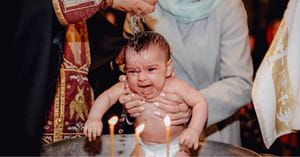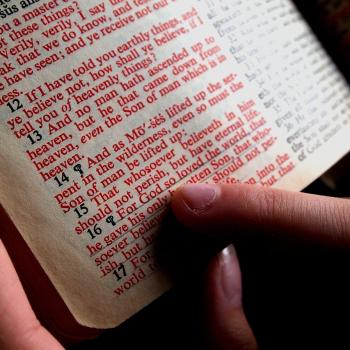
While Baptism is one of the most universal of all Christian sacraments, it is also one of the rites that has the most variety in how and why it is performed. The ordinance was certainly approved by and engaged in by both Jesus and John the baptizer. However, it almost certainly has its origins in the pre-New Testament era. And yet, in the two thousand years since this rite has been one of the sacraments of the Church, a great deal of evolution has developed. Whether directly or indirectly, the Bible teaches a number of principles regarding baptism, its mode and necessity. Though the various Christian Churches tend to interpret the key passages in various ways, certain aspects of baptism are undeniably clear in the New Testament. Let’s look at some of the most important New Testament teachings regarding this common Christian rite.
Baptism Should be by Immersion:
The four gospels, the epistles of Paul, and the book of 1 Peter each speak of baptism as an early Christian sacrament, rite, or ordinance. The Greek word (used in the New Testament) for “baptize” is βαπτίζω, which means literally to “immerse” or “submerge.” The word appears 80 times in the Bible (in 28 different forms)—each meaning that baptism was understood (in the biblical era) as an ordinance that required that the participant be entirely submerged in water. Thus, John 3:23 tells us that John the Baptist baptized in Aenon, near Salim, specifically “because there was much water there.” Not surprisingly then, Matthew 3:16 indicates that when Jesus was baptized, He went down into the river and (after His baptism) came “up out of the water,” indicating immersion. Paul taught (in Romans 6:3-6) that baptism was a symbol of the death, burial, and resurrection of Jesus—and, thus, it was performed in New Testament times by immersion because that allowed for that symbolism of laying down in the water, being covered by the water, and then coming up out of the water. Among early Christians, any form of baptism other than total immersion destroyed the symbolism of burial. Thus, in Colossians 2:12, Paul spoke of being “buried with Christ in baptism.”
Baptism Should be in the Name of the Trinity:
In Matthew 28:19, Jesus told his apostles that they should baptize people “in the name of the Father, and of the Son, and of the Holy Spirit.” In other words, Jesus instituted the trinitarian formula as part of proper baptism, indicating that He wanted Christians to be baptized in the name of the three members of the Godhead.
Baptism Should be for Repentance and the Remission of Sins:
In Mark 1:4, we read that John “proclaimed a baptism of repentance for the forgiveness of sins.” In other words, John did not teach baptism as simply or solely an “outward sign of an inward commitment,” but an actual rite “for the remission of sins” and for the “repentance” of the person who received this sacrament. Jesus clearly embraced this same view, as He told His apostles to teach those whom they baptized to then “obey everything that [He had] commanded” them. (Matthew 28:19-20). Thus, Paul would later tell those who had accepted Christ, “Get up, be baptized, and have your sins washed away.” (Acts 22:16) And, to the believers in Galatia, Paul said that the baptized should “put on Christ” (Galatians 3:27) The Greek of this verse suggests that one essentially “clothed” themselves in the attributes of Jesus—which implies repenting of one’s sinful ways, and living a new way; the way Jesus did.
Baptism Should be Understood to be Essential:
When Jesus approached John the Baptist, requesting baptism of him, John said “I have need to be baptized of you.” However, Jesus explained to John that He needed to be baptized, “because this is the way for us to fulfill all righteousness.” And, therefore, Jesus was baptized by immersion (by John) in the River Jordan. (Matthew 3:14-15) Accordingly, as part of His “great commission” to His apostles, Jesus explained: “The one who believes and is baptized will be saved,” so “go ye into all the world and preach the gospel to every person.” (Mark 16:15-16) Similarly, Jesus told Nicodemus that “unless a person is born from water and the Spirit, he cannot enter the Kingdom of God.” (John 3:5) While some have tried to interpret this as meaning, unless you’re born of amniotic fluid (the “water”) and then “born again” (“of the Spirit”) you “cannot enter the Kingdom of God.” However, the Greek simply won’t support such a reading. The Greek for amniotic fluid is αμνιακό υγρό. However, the Greek word for water (used in John 3:5 and also in Matthew 3:16, where Jesus was baptized) is ὕδατος. (This is this is the same Greek word from which we get our English word “hydrate,” and it is the same Greek word used for water every time the New Testament speaks of it in relation to baptism.) Thus, Jesus could not possibly have been referring to amniotic fluid when He said a man “must be born of water…or he cannot enter the Kingdom of God.” The Greek is clear that Jesus is saying that baptism is essential.
Baptism Should be Performed by Proper Authority:
In the New Testament, the concept of “authority” is often emphasized. Not only did Jesus “ordain” His apostles, giving them “power” and “authority” (Matthew 10:1-4), but the Apostle Paul also “ordained” (or conferred authority on) “elders in every city” (Titus 1:5). In Acts chapter 19, two episodes highlight the importance of “authority” in the early Christian Church. The first episode (19:13-16) tells of some men practicing exorcisms, but without authority. The evil spirit in the possessed man recognized that they men didn’t have proper authority and, so, instead of obeying the exorcists’ command to depart, the evil spirit came out of the possessed man and attacked the exorcists—leaving them “wounded.” The second episode (19:1-6) deals specifically with the issue of baptism needing to be performed by proper authority. While in Ephesus, Paul met some disciples who had been baptized, but had not “received” or even “heard of” the Holy Spirit. “So, Paul asked them, ‘When someone baptized you, what kind of baptism was that?’ ‘We received the baptism that John spoke about,’ they answered.” (19:3) Concerned that whoever baptized them didn’t have proper authority—even though they baptized after the manner John baptized—Paul rebaptized them (to endure it was done properly and by proper authority), and then he laid his hands on them so that the Holy Ghost would “come upon them.” (19:4-6) Though both vignettes indicate that there is such a thing as “invalid” authority, nonetheless, the story about re-baptism highlights the New Testament teaching that a baptism not done properly and not done by proper authority is invalid in the eyes of God.
Baptism in Various Christian Denominations:
While the New Testament has some very specific teachings on baptism and its need to be performed by proper authority, in the name of the three persons of the Holy Trinity (or Godhead), for repentance and remission of sins, and as an essential act associated with one’s acceptance of Christ and His saving grace, the various Christian denominations which practice baptism have a variety of views on its practice and purpose. Let’s briefly examine (in alphabetical order) some of the major Christian traditions and how they view this rite as part of their approach to the teachings of Jesus and the Bible.
Anglicanism:
In the Anglican or Episcopal tradition, baptism is typically understood to be salvific, or “necessary to salvation”—though not all Anglicans see it as such. Baptism is performed for infants, and by affusion, which is the pouring of water on the head of the person being baptized. Converts are also typically baptized by affusion, though Anglicanism accepts baptism by immersion (for adults) if a sufficiently deep pool of water for performing such a baptism is available. Converts are typically baptized during the Easter Vigil (on the night before Easter morning).
Baptist:
There are various branches of the Baptist tradition. However, customarily, Baptists do not believe baptism is a sacrament and, thus, they do not see it as requisite for salvation. It is considered an outward sign of an inner commitment to Christ and should only be performed for those who are old enough to accept Jesus as their personal Savior.
Catholicism:
In the Roman Catholic tradition, baptism is understood to be sacramental, meaning it is important for the salvation of the individual. Catholic baptism takes place in one’s infancy and not long after birth, except for converts (who are typically baptized at the Easter Vigil). Baptism is performed by affusion.
Eastern Orthodoxy:
In the Eastern Orthodox tradition, baptism is understood to be a necessary sacrament of the Church and commanded of all believers. It traditionally takes place in one’s infancy, typically between 40-100 days after birth. Baptism of infants is performed by a triple immersion, followed by Chrismation (which is an anointing with oil). Adult converts to Eastern Orthodoxy enter the faith at Easter, either by the affusion of water, followed by chrismation—or just by chrismation.
Jehovah’s Witnesses:
In the Witness tradition, baptism is traditionally understood to be “a vital step toward gaining salvation.” Jehovah’s Witnesses only baptize adults and do so by total immersion. They traditionally hold their baptismal services at their annual conventions (or assemblies). They perceived baptism as entrance into “Jehovah God’s Kingdom,” but also an ordination. Thus, all who are baptized as Jehovah’s Witnesses are, by virtue of their baptism, “ordained” ministers of Jehovah.
Lutheranism:
In the Lutheran tradition, baptism is seen as “necessary, but not absolutely necessary” for salvation. In other words, one would not be denied salvation if not baptized. In Lutheranism, baptism is performed at any age, from infancy to adulthood, and is usually done by either sprinkling or affusion. For adults who are converting to the Lutheran faith, baptism typically takes place as soon as possible after one embraces the faith.
Methodism:
In the Methodist faith, baptism is not seen as necessary for salvation. Traditionally performed by sprinkling, Methodists allow for both infant and adult baptisms. While baptism makes one a member of the Church, Methodists do not believe that it determines who enters heaven.
Pentecostalism:
There are many branches of Pentecostalism. However, for most Pentecostals, baptism by immersion is seen as necessary for salvation. That being said, many Pentecostals feel that baptism by the Holy Spirit is more important than baptism in water, in that it evidences true conversion. Pentecostals only baptize adults; never infants.
Seventh Day Adventists:
For Adventists, baptism is not seen as salvific. While it represents one’s commitment to Christ, it is merely an outward sign of an inner commitment. Baptism is by immersion in the Adventist tradition, and only for those old enough to understand the meaning of the rite. Thus, many Adventists congregations will baptize youth, but infant and child baptisms are traditionally rejected.
The Church of Christ, Science:
The Christian Science movement does not practice baptism (in the traditional sense of the word). Their founder, Mary Baker Eddy, explained: “Our baptism is a purification from all error.” In other words, as one strives daily for self-improvement, one is daily being “baptized” simply by coming closer to God. However, any form of water baptism does not exist in the Christian Science tradition.
The Church of Jesus Christ of Latter-day Saints:
Members of the Church of Jesus Christ believe baptism is a “saving ordinance” and, thus, is needed by all in order to be saved or “exalted” (as they say). Thus, Latter-day Saint Christians not only baptize their own (starting at no younger than eight years of age), but—following Paul’s teaching in 1 Corinthians 15:29—they perform what are called “baptisms for the dead.” This means that one who has already been baptized can then go to a Latter-day Saint temple and be baptized for and in behalf of those who did not have the opportunity to be baptized while they were alive. Latter-day Saints baptized by total immersion.
Non-Christian Parallels with Baptism
Washing rites, in one form or another, are common in various world religions—either as a means of joining the faith or in order to be pronounced clean (or acceptable) so that one can engage in worship of the god or goddess, or to participate in other rites associated with the tradition. While none of what follows is identical to the Christian rite of baptism, each has some connection in how the rite is performed or in what the rite means or accomplishes.
Judaism:
A mikveh is a ritual bath of purification, common mostly in the Orthodox denominations of Judaism. While it is used on the eve of Yom Kippur (by both men and women) in order to approach God (on the Day of Atonement) in a state of ritual purity, and also by Orthodox women one week after the conclusion of the menstrual cycle, it is also used for conversion in some Jewish traditions.
For Jews who use the mikveh for converts, it traditionally has a triple meaning. It symbolizes the convert’s entrance into the community. It indicates a transition from one’s old life to a new life. And it represents repentance and the forgiveness of sins.
Some scholars actually think that John the Baptizer’s “baptisms” were simply a form of the Jewish mikveh. Those who hold that view argue that (1) this explains why the Jewish leadership of John’s day do not criticize the use of this rite, and (2) it explains the origins of Christian baptism. Much of how a mikveh is performed has parallels with Christian baptism by immersion.
Islam:
In Islam, there are multiple forms of ritual washing, but two umbrella categories; wudu (which is a partial ablution) and ghusl (which is a full body ritual purification or bath).While the former is often used before engaging in daily prayer, particularly after one has used the restroom, passed gas, or experienced light bleeding; the latter of the two is often participated in after sexual intercourse, before engaging in the Hajj (or pilgrimage), prior to Friday prayers, or before prayers on certain annual holidays. Because converts are expected to participate in ghusl as part of their conversion rite, in some ways, it parallels baptism in Christianity. Indeed, just as baptism is often accompanied by vows or covenants (in Christianity), ghusl is traditionally engaged in following the making of an oath or vow. Whereas baptism by immersion covers the entire body, but all at once, ghusl is a multi-step process by which one systematically washes the entire body with intent. It is the mandatory “ritual bath” of all converts to Islam.
Sikhism:
Not all practitioners of Sikhism get baptized. Actually, only about one in three Sikhs have engaged in “Amrit Sanskar,” or baptism. The rite of baptism is only required for those who join the Sikh Khalsa—and organization that functioned (in Sikhism’s early years) as a military order designed to protect the members of the faith from persecution. Today, members of the Khalsa are often seen as being among the most faithful Sikhs.
Sikhs are usually baptized in a quite location (where a spirit of reverence can be felt), and one where the scriptures are present—not unlike Christian baptism. The initiate is to bathe prior to the ceremony, including washing the hair. One takes upon himself or herself the “Five Ks”—unshorn hair, a small dagger, a special pair of underpants, a comb in the hair, and a steel bracelet. After committing to live the principles of the order, the initiate is sprinkled on the eyes and hair five times with specially prepared sweetened water. The remaining nectar is then consumed by the initiate. The rite looks less like baptism by immersion but has some parallels with baptism by affusion.
Hinduism:
The top three Hindu casts—Brahmins, Kshatriyas, Vaishyas—participate in a rite known as the “Twice Born” ceremony. Like Christian baptism, which is typically associated with being “born again,” the twice born ceremony is designed to be a rebirth, a spiritual “new beginning” for the participants. Traditional practices (as part of the Hindu rite) include shaving off the hair, so that one looks somewhat like a newborn. The initiate is then bathed, and it is common to give him a new set of clothes and a new name. He receives a “sacred thread” that is a reminder of the responsibilities he has taken upon himself, and he should wear one of these sacred threads from his left shoulder to his right hip for the remainder of his life.
While the outward aspects of this rite mirror baptism only in surface ways, some of the symbols have parallel meanings. The idea of being “born again” and making a commitment to live a “new type of life”—even the receipt of a “new name” (much like one’s “Christian name” or “baptismal name”)—clearly evidence the similarity in meaning, if not in practice.
Zoroastrianism:
The Zoroastrian Navjote is the initiation rite through which Zoroastrian boys and girls (never younger than seven and typically not older than fifteen) formally commit to live the principles of the faith and take upon themselves certain spiritual obligations. Prior to the ceremony, the young initiate is bathed in sacred water as a representation that they are being cleansed in anticipation of taking upon themselves new duties and obligations. They stand before the fire (a symbol of the God of Zoroastrianism) while the Mobed (or priest) performing the rite recites a prayer of repentance on their behalf. The initiate then receives a special undergarment (called a sudreh), and he or she recites the “articles” of the Zoroastrian faith.
While there are other components to the rite, its parallels with Christian baptism are to be found in the act of repentance, the washing of the initiate, the wearing of a white garment (common in many Christian traditions), and the becoming (through this rite) a member of the community.
Shinto:
Miyamairi is the Shinto rite of blessing a newborn, which takes place at a Shinto shrine. Though traditionally Japanese children experienced their Miyamairi (or “shrine visit”) at 31 days old (if male) or 33 days old (if female), today the rite is typically performed somewhere between one and approximately three months of age. The rite consists of bringing the newborn to the shrine, where it is believed that many spirits (or kami) are present. The parents present the child at the altar of the shrine, where they make an offering of gratitude to the kami for the blessing of having a child. The officiant will typically pray for the child that it might enjoy good health and a long and prosperous life. Part of the priest’s prayer informs the spirits of the child and its parents’ names, as well as their address—so that they spirits can make their way to the family home, blessing and protecting those who dwell therein.
While this rite is not identical to Christian baptism, in many ways, it mirrors christening rites in some Christian traditions.
Conclusion
While the Bible seems clear on baptism’s place, purpose, and mode in the Christian faith, history shows that not all Christians read the Bible in the same way. Thus, a significant amount of variety exists between the various Christian traditions on this very fundamental and even sacramental rite. Curiously, most world religions have some parallel ritual that looks or has purposes akin to Christian baptism, perhaps indicating that this ordinance is more universal than many realize, and most likely had divine origins, even if the teachings surrounding this sacred washing rite have gotten somewhat convoluted over the centuries. Nonetheless, the central principle that one must be cleansed by water in order to approach God seems to be a universal truth—in the various Christian denominations, but across world religions as well.
12/14/2023 10:08:31 PM











